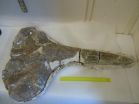(Press-News.org) Researchers have fine-tuned a technique for coating gold nanorods with silica shells, allowing engineers to create large quantities of the nanorods and giving them more control over the thickness of the shell. Gold nanorods are being investigated for use in a wide variety of biomedical applications, and this advance paves the way for more stable gold nanorods and for chemically functionalizing the surface of the shells.
Gold nanorods have a lot of potential applications, because they have a surface plasmon resonance - meaning they can absorb and scatter light. And by controlling the dimensions of the nanorods, specifically their aspect ratio (or length divided by width), you can control the wavelength of light they absorb.
"This characteristic makes gold nanorods attractive for use in catalysis, security materials and a range of biomedical applications, such as diagnostics, imaging, and cancer therapy," says Joe Tracy, a materials science and engineering researcher at NC State who is senior author of a recent paper on the improved technique.
Gold nanorods are efficient for photothermal heating, the process of converting absorbed light into heat. If too much light is shined on gold nanorods, however, they can lose their rod shape and change into spheres, losing their desirable optical properties.
One way to help gold nanorods retain their shape during photothermal heating is to coat them with silica shells, which confine the nanorods to their original shape but allow light to pass through. For different applications, it is important to be able to control the shell thicknesses. With thin shells, the change in size of the nanorods is minimal, and the gold nanorods can still pack into dense assemblies. On the other hand, thicker shells can act as buffers, preventing nanorods from bunching closely together and shielding them from their environment.
Silica shells also provide a surface that can be functionalized using well-understood chemical techniques. For example, the shells could be functionalized to fluoresce in the presence of specific proteins or to target tumors.
"The silica shells offer multiple benefits - and our modified approach to coating gold nanorods with silica shells has two distinct advantages," Tracy says.
"First, we have demonstrated that our technique can be carried out on a large scale - up to 190 milligrams," Tracy says. "Second, we offer improved control over shell thickness. We can consistently create uniform shells as thin as 2 nanometers."
The modified technique has two steps.
"First we apply a reagent called TEOS to the gold nanorods in solution," says Wei-Chen Wu, a Ph.D. student in Tracy's lab and lead author of the paper. "Once in solution, the TEOS begins to form a silica shell on the nanorods. We then introduce another reagent called PEG-silane into the solution. This stops the shell from growing thicker."
INFORMATION:
The paper, "Large-Scale Silica Overcoating of Gold Nanorods with Tunable Shell Thicknesses," is published online in the journal Chemistry of Materials. The work was supported by the National Science Foundation under grant DMR-1056653, the National Institutes of Health under grant 1R21HL111968-01A1, and the NSF's Research Triangle Materials Research Science and Engineering Center under grant DMR-1121107.
This news release is available in Spanish. Alzheimer's disease is the most significant cause of dementia in the elderly: it affects over 35 million people worldwide. It is reckoned that Alzheimer's could reach epidemic proportions in developed countries unless therapies to cure or prevent it are obtained. Studies conducted so far reveal that the therapies are more effective when they are applied before the brain has become severely damaged. What is more, the spotting of early phases of the disease may help to develop new treatments. Right now, to make a clinical diagnosis ...
A new microarray-based tool, called VaginArray, offers the potential to provide a fast, reliable and low-cost assessment of vaginal health and diagnoses of infections. The research is published ahead of print March 2, in Antimicrobial Agents and Chemotherapy, a journal of the American Society for Microbiology.
The VaginArray has 17 probe sets, each one specific for one of the most representative bacterial species inhabiting the vaginal ecosystem, including those associated with both healthy and unhealthy conditions. Each probe set is designed to be complementary to the ...
ALBUQUERQUE, N.M. -- Researchers at Sandia National Laboratories' Z machine have helped untangle a long-standing mystery of astrophysics: why iron is found spattered throughout Earth's mantle, the roughly 2,000-mile thick region between Earth's core and its crust.
At first blush, it seemed more reasonable that iron arriving from collisions between Earth and planetesimals -- ranging from several meters to hundreds of kilometers in diameter -- during Earth's late formative stages should have powered bullet-like directly to Earth's core, where so much iron already exists.
A ...
This news release is available in French. Basic research on blood pressure has led researchers from Inserm (Inserm Unit 1138, "Cordeliers Research Centre") to obtain unexpected results: drugs used to treat hypertension (high blood pressure) reduce side effects from corticosteroid-based creams used to treat certain skin diseases.
This work is published in the Journal of Investigative Dermatology.
Corticosteroid-based dermatological creams are indicated for the symptomatic treatment of inflammatory skin conditions, such as atopic dermatitis and psoriasis, for example. ...
Uplift associated with the Great Rift Valley of East Africa and the environmental changes it produced have puzzled scientists for decades because the timing and starting elevation have been poorly constrained.
Now paleontologists have tapped a fossil from the most precisely dated beaked whale in the world -- and the only stranded whale ever found so far inland on the African continent -- to pinpoint for the first time a date when East Africa's mysterious elevation began.
The 17 million-year-old fossil is from the beaked Ziphiidae whale family. It was discovered 740 ...
This news release is available in German.
FRANKFURT. The discovery of the soccer ball-shaped C60 molecule in 1985 was a milestone for the development of nanotechnology. In parallel with the fast-blooming field of research into carbon fullerenes, researchers have spent a long time trying in vain to create structurally similar silicon cages. Goethe University chemists have now managed to synthesise a compound featuring an Si20 dodecahedron. The Platonic solid, which was published in the "Angewandte Chemie" journal, is not just aesthetically pleasing, it also opens ...
This news release is available in French. With a population likely to grow 27% by 2031, putting an end to urban sprawl in Greater Montreal appears impossible for the short to medium term. But it is possible to slow the pace of urban sprawl by harnessing the full development potential of central areas, according to forecasts by Guillaume Marois, a recent Ph.D. from INRS who has developed a spatial microsimulation model called Local Demographic Simulations (LDS).
These findings are presented in an article co-authored by Guillaume Marois and Professor Alain Bélanger ...
Women who have difficulty getting pregnant often turn to in-vitro fertilization (IVF), but it doesn't always work. Now scientists are taking a new approach to improve the technique by studying the proteins that could help ready a uterus for an embryo to implant in its wall. Their report could help researchers develop a new treatment that could potentially increase the success rate of IVF. The study appears in ACS' Journal of Proteome Research.
Chen Xu, Hu Zhou and colleagues note that nearly 50 million couples worldwide require some kind of medical intervention to conceive. ...
New York (18 March 2015)--"Consensual unions," two people living in the same dwelling in a relationship akin to marriage, have been an integral part of family life in Latin America for centuries. In fact, in Latin America, legal marriages and consensual unions are seen as similarly acceptable family arrangements for bearing and raising children. However, consensual unions have historically been more common among disadvantaged populations and in rural areas than among more advantaged populations and in urban areas--indicating that such unions are rooted in limited economic ...
Plastic products advertised as biodegradable have recently emerged, but they sound almost too good to be true. Scientists have now found out that, at least for now, consumers have good reason to doubt these claims. In a new study appearing in the ACS journal Environmental Science & Technology, plastics designed to degrade didn't break down any faster than their more conventional counterparts.
Susan Selke, Rafael Auras and colleagues note that to deal with our plastic waste problem, many countries and local governments have adopted laws, such as single-use bag bans, to ...

